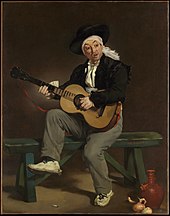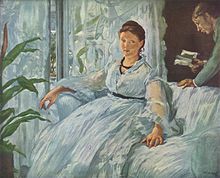Edouard Manet

Édouard Manet (born January 23, 1832 in Paris , † April 30, 1883 there ) was a French painter . He is considered to be one of the pioneers of modern painting.
Life
childhood
Edouard Manet was born in 1832 in house number 5 on rue des Petits-Augustins (now rue Bonaparte) in the Saint-Germain-des-Prés district of Paris . The house where he was born is located directly opposite the Académie des Beaux-Arts, not far from the Louvre . He came from a middle-class family with a republican disposition. His father, Auguste Manet , was a judge and worked as the head of the human resources department in the Ministry of Justice. The mother Eugénie-Désirée Manet, née Fournier, was the daughter of a French diplomat who worked as a consul in Gothenburg. The Swedish King Charles XIII. was one of the godparents of the mother. Eugénie-Désirée Manet excelled as a singer at house concerts. The parents had inherited estates in Gennevilliers , where Manet's grandfather was mayor. The house there served the family as a summer residence and the leased land enabled an upscale lifestyle. Édouard Manet's younger brothers were Eugène, born in 1833, and Gustave, born in 1835. The uncle Edmond-Édouard Fournier accompanied Édouard Manet and his brother Eugène repeatedly to the Louvre to view the works of art there.
From 1838 to 1844 Manet attended the institute school in Vaugirard led by Abbé Poiloup . He then moved to the prestigious Collège Rollin (today's Lycée Jacques Decour ), where he finished his school education in 1848. There he met Antonin Proust , who later became journalist and politician , with whom he had a lifelong friendship. Manet attracted attention during his school days for bad behavior and insufficient performance. Manet was popular with his classmates because he drew caricatures of them and their teachers. Manet's uncle Fournier recognized the student's talent for drawing and paid him optional drawing lessons at the Collège Rollin. During these years Manet made his first drawings based on Old Masters in the Louvre and also drew in the great outdoors on excursions to Vincennes .
The trip to Brazil
After finishing the Collège Rollin, Manet sought a career as a naval officer. His parents agreed to this idea, as the father's wish that his eldest son should also pursue a legal career was ruled out due to poor academic performance. In the entrance exam for the Naval School ( École Navale ) near Brest at the end of July 1848, however, Manet failed. In preparation for a repeat examination the following year, Manet embarked on December 9, 1848 on the training ship Le Havre et Guadeloupe , with which he set off on a six-month voyage to Brazil. Numerous letters from Manet to relatives have survived from this trip, in which he reported on the experiences of the sea voyage, the Carnival in Rio de Janeiro and the beauty and exotic charm of Brazilian women. On the other hand, sixteen-year-old Manet took a critical look at slavery and expressed concern about the possible reintroduction of the monarchy in France. During his time on board the ship, Manet again drew caricatures, which, like those from school, have not survived. The experiences of the sea voyage led Manet to the decision not to take the examination of the naval school again and to choose the profession of painter instead. Manet's later pictorial work consists of about a tenth of sea views, whereby the trip to Brazil certainly played an inspiring role.
Training in Thomas Couture's atelier
After his return from Brazil Manet was able to convince his father to agree to an apprenticeship as a painter. The choice of the training location turned out to be more difficult, since Manet's father preferred the classical training at the Académie des Beaux-Arts, Manet himself preferred a studio class with an artist. The two finally agreed on the studio of Thomas Couture , who had celebrated a triumphant success with his painting The Romans of the Decay in the Paris Salon of 1847. At the time, couture was considered a progressive artist whom numerous young painters admired. In 1850, Édouard Manet began his training here, which mainly consisted of working in front of living models. In the painting class there were mostly 25 to 30 students who came not only from France, but also from Germany and the USA. The German painters Anselm Feuerbach and Victor Müller were in the Atelier Coutures at the same time as Manet, and Manet's school friend Antonin Proust also attended classes. Manet initially admired the skills of Couture, who visited his students twice a week to assess their progress. After about half a year, however, Manet began to criticize the unnatural attitude of the models and the teaching methods of coutures, which led to considerable and lasting conflicts. Manet therefore also attended the Académie Suisse in the afternoon to work free of conventions. He also copied paintings in the Louvre. Of these, Madonna with the rabbit and Jupiter and Antiope of Tiziano and the self-portrait of Tintoretto obtained. During the time of his training Manet went on a few study trips. In 1853 he traveled with couture and his students to the Normandy coast to paint in the great outdoors. Manet's father also financed some trips abroad. In 1852 Manet visited the Rijksmuseum in Amsterdam , and in 1853 the museums of Kassel , Dresden , Prague , Vienna and Munich follow . In the autumn of 1853, Manet and his brother Eugène toured Venice , Rome and Florence , where he copied Titian's Venus de Urbino and the Portrait of a Young Man by Filippino Lippi . In 1854 he went to Eugène Delacroix with Antonin Proust in order to obtain permission from him to copy his Dante barque . Two oil paintings by Manet were created based on this model. Despite the difficult relationship between couture and Manet, he stayed in the studio class for six years before separating from him in 1856 and moving into his first studio with his friend, animal painter Albert de Balleroy .
First years in the Rue Lavoisier
Little is known about Manet's work up to 1859, the time when he shared a studio with Balleroy on Rue Lavoisier. One reason for this is that there are hardly any records by Manet or his contemporaries about the origin of the early works. The chronological assignment of the early paintings is made more difficult by Manet's way of working, in which he repeatedly revised his works over the years. In addition, Manet later destroyed part of his early pictures.
The pictures that have been preserved from the first few years do not yet reveal the artist's own style. He copied old master paintings, just as he did when he was an apprentice at couture. These include works based on Dutch models such as The Anatomy of Dr. Tulip by Rembrandt van Rijn or The Smoker by Joos van Craesbeeck as well as motifs by Italian artists. On another trip to Florence in 1857, Manet drew sketches of the Madonna del Sacco based on frescoes by Andrea del Sarto in the Basilica della Santissima Annunziata . Other religious themes in the early years are various oil sketches depicting Christ and an unfinished painting The Finding of Moses , of which only one study exists today. The original painting draft was later cut up by Manet and the section with the female figure revised to create the painting The Surprised Nymph .
Friends Manet made in the late 1850s included painters Edgar Degas and Henri Fantin-Latour , who later portrayed Manet several times. Manet also became friends with the poet Charles Baudelaire during this time. His cycle of poetry, Les Fleurs du Mal , inspired Manet to create his first independent painting The Absinthe Drinker . Baudelaire in turn wrote his poem La Corde after Manet's assistant had hanged himself in the studio. This boy had previously been portrayed by Manet in the picture Boy with Cherries . After this incident, Manet moved into his own studio on rue de la Victoire.
Premiere in the salon
The Salon de Paris , which initially took place every two years in 1859, represented the most important opportunity for visual artists to gain official recognition, attention in the press and potential buyers. Manet chose the painting The Absinthe Drinker, begun in 1858, for its premiere in the Salon . This life-size representation of a Parisian rag collector was based on a real person. Manet's painting was based on the work of the Spaniard Diego Velázquez, whom he admired . However, the salon jury rejected the painting. Only the jury member Eugène Delacroix spoke out in favor of Manet's work. Manet suspected that the jury's rejection was an intrigue of his former teacher Thomas Couture, with whom he finally fell out.
For the subsequent Salon in 1861, Manet submitted two paintings, both of which were accepted by the jury. The portrait of the parents , in the tradition of realism by Louis Le Nain , was probably modeled on Dutch portraits of the 17th century - for example by Rembrandt or Frans Hals . Although the parents portrayed were satisfied with the painting, the painting did not receive any positive reviews in the salon.
The second painting by Manet for the Salon of 1861 was Guitarrero (or The Spanish Singer ). After the failure with the Parisian subject of the absinthe drinker, Manet hoped for recognition in the salon with a motif corresponding to the Spanish fashion of the time. The depiction of a singing guitarist, which was also influenced by Diego Velázquez, was regarded by some critics as exaggerated realism , but was admired by renowned painters such as Delacroix and Jean-Auguste-Dominique Ingres . The art critic Théophile Gautier emphasized both the bold brushstroke and the lifelike colors of the picture. At the end of the salon, Manet also received an honorable mention from the salon jury as recognition . Due to the success of this painting, a group of young painters quickly gathered around Manet, including Henri Fantin-Latour, Felix Bracquemond , Emile Auguste Carolus-Duran and Alphonse Legros , who soon saw Manet as their leader. The writers Charles Baudelaire, Jules Champfleury and Édmond Duranty also belonged to this environment .
Suzanne and Léon Leenhoff
In 1860 Manet left his parents' house and moved into their first apartment in the Batignolles district with the two years older Dutch pianist Suzanne Leenhoff and her son Léon . He had already met Suzanne in 1849 when she was giving piano lessons to his younger brothers. It is unclear who the father of Léon, born in 1852, was, whom Suzanne passed off as her younger brother in Paris. Manet's trip to the Netherlands in 1852 coincided with the birth of Léon. Many authors have assumed the paternity of Édouard Manet, who officially only acted as the child's godfather. However, recent research suggests that Auguste Manet was a father, which would have made Léon a half-brother of Édouard Manet. Manet, who for the time being kept his relationship with Suzanne a secret from his friends, did not marry the Dutch woman until 1863 after his father had died the previous year. Both Léon and Manet's mother lived in the household of Édouard and Suzanne Manet until Manet's death. The two women of the household ran a weekly literary salon together , to which guests such as Degas, Fantin-Latour, Bracquemond and Duranty came. The painters Alfred Stevens and Frédéric Bazille , the composer Emmanuel Chabrier and the writer Zacharie Astruc were among the visitors to the Manet house. In the 1860s in particular, Manet made numerous portraits of Suzanne and her son Léon Leenhoff was Manet's most frequently portrayed of all family members.
The stroller
Unlike most of his later Impressionist painter colleagues, Manet was a staunch city dweller all his life and rarely and reluctantly left Paris, except for study trips abroad or during the summer holidays. Manet did not live secluded in his painter's studio, but strolled through the streets of his hometown every day - elegantly dressed in top hats and gloves in the manner of a dandy - and regularly visited restaurants, cafes and variety theaters, where he met progressive painters, writers and politicians. These artist eateries initially included the Café Guerbois , the Café de Bade and the Café Tortoni , followed by the Café de la Nouvelle Athènes , the Brasserie Reichshoffen and the Folies Bergère in the 1870s . In 1862, the group portrait Music in the Tuileries Garden , Manet presented himself with the painters Albert de Balleroy and Henri Fantin-Latour, the writers Zacharie Astruc, Théophile Gautier and Charles Baudelaire, and the composer Jacques Offenbach as part of Parisian bourgeois society. Music in the Tuileries Garden is one of Manet's earliest paintings, in which he thematized la vie moderne - modern life. In doing so, he followed an appeal that Baudelaire had addressed to artists in 1859. Representations of the vie modern became characteristic of Manet's work in the later creative years. In Maskenball im der Oper , a work composed a decade later, Manet repeated the subject of a group portrait with friends, but relocated the event to an interior room.
1862 is also the year in which Manet - inspired by the editor Alfred Cadart and the photographer Félix Chevalier - founded the Societé des Aquafortistes together with Bracquemond, Fantin-Latour, Alphonse Legros , Johan Barthold Jongkind and Augustin Théodule Ribot . This artists' association had set itself the goal of promoting the art of etching . Especially in the 1860s, Manet made numerous etchings after his paintings, some of which were published.
Spanish fashion in the 19th century
Before the 19th century, Spanish painting received almost no attention in France, whose artists were mainly based on Italian art. This changed at the beginning of the century when Spanish works of art were temporarily looted in the Louvre during the Napoleonic Wars . Thirty years later, the bourgeois king Louis-Philippe showed himself to be particularly fond of the art of Spain, whose collection of Spanish paintings was exhibited in the Louvre as the Galerie Espagnole from 1838 to 1848 . As an adolescent, Édouard Manet must have seen this collection during his visits to the Louvre. There was a real Spanish fashion since the 1850s, after Napoleon III. the Spanish native Eugénie de Montijo had married. A high point of this Spanish fashion was the guest performances of a dancer troupe from the Teatro Real de Madrid in the early 1860s , whose performances were enthusiastically received by the audience - including Édouard Manet.
Motivated by the success with the Spanish singer in the Salon of 1861 and influenced by the general enthusiasm for everything Spanish, Manet turned increasingly to Spanish motifs. His Mademoiselle V ... in the costume of a bullfighter from 1862 does not show a real Spaniard, but Manet's preferred model from the 1860s - the French Victorine Meurent - in a fantasy costume that should appear Spanish. Manet's brother Gustave, on the other hand, was wearing original Spanish clothes when he portrayed him in 1863 in Young Man in Majo Costume . Manet found Spanish models in the dance troupe of the Teatro Real, which he portrayed as a group in The Spanish Ballet . He also made individual portraits of the soloists Mariano Camprubi and Lola Melea, known as Lola de Valence . Manet painted Lola de Valence, whom Baudelaire described as “a beauty of dark and at the same time lively character”, based on the model of Francisco de Goya's portrait of the Duchess of Alba . The masculine beauty of Lola de Valence inspired Manet's friend Zacharie Astruc to perform a serenade , the text and music of which he wrote. Manet drew a lithograph after his painting Lola de Valence for the cover of the printed version of this serenade.
Spanish painting remained a constant source of inspiration for Manet until his later work. Diego Velázquez played a central role here, but motifs by Francisco de Goya can also be found repeatedly as models in Manet's work; occasionally the influence of El Greco can be felt. The painters Murillo , Ribera and Zurbarán , however, did not play a significant role in Manet's work.
Further life
In the years to come he met with great rejection at the Salon de Paris . His picture Breakfast in the Green was seen as a collection of "ugly naked women", which was rejected by the salon out of consideration for morality and because of the raw style. It was exhibited in the Salon of the Rejected ( Salon des Refusés ) in 1863 . In 1865, the painting Olympia in the salon became a major scandal.
Soon a number of like-minded naturalists emerged , from which Impressionists gradually split off. Manet had a great influence on young artists, although officially he was usually only rejected. Manet was on friendly terms with the young impressionist artists, but never considered himself a part of this style.
Graphics, landscapes, portraits and still lifes complete his work. His most characteristic images include: The Dead Man , The Child with the Sword , Olympia , The Spanish Ballet , The Railway , The Café Concert , The Canotiers of Argenteuil , The Laundry (1876), the portrait of his sympathetic friend Zola , The good drink and the bar in the Folies-Bergère (1882).
For the portrait of M. Henri Rochefort Manet was awarded a second class medal in the Salon in 1882. In the same year he was made a Knight of the Legion of Honor .
In 1870, the lifelong friendship with Édmond Duranty came into a short-term crisis after Duranty had published an exhibition review that was as brief as it was critical in the Paris Journal. Manet then slapped Duranty in the Guerbois and met him on February 23, 1870 in the forest of Saint-Germain for a degenduell. After Duranty was lightly wounded in the chest, they both agreed that their honor was now restored. All those involved, including Manet's second Émile Zola, then contributed to the legend of this act in the artists' quarters of Batignolles and Montmartre.
Manet met Berthe Morisot , who is considered to be one of the most famous painters of impressionism, and portrayed her repeatedly between 1872 and 1874. From 1874 Manet was related by marriage to Morisot through his brother Eugène.
Manet had suffered from syphilis since the late 1870s . On April 20, 1883, his left leg was amputated. He died on April 30, 1883 in Paris and was buried on the Cimetière de Passy (Division 4, approximate burial location: 48 ° 51 ′ 44.9 ″ N , 2 ° 17 ′ 6.9 ″ E ).
Public opinion about his art only became more positive a year after his death on the occasion of an exhibition of his life's work.
Works (selection)
This list contains 39 works by Manet, which represent a representative cross-section of his work. Manet made the selection himself. These are all works that he submitted to the Salon de Paris (including those that were rejected by the Salon jury). For the complete works of Manet see the article Catalog raisonné by Édouard Manet or the list of paintings by Édouard Manet , List of pastels by Édouard Manet .
| Title (year of creation) | Dimensions, material | Salon de Paris | Location | |
|---|---|---|---|---|

|
The Absinthe Drinker (1858-1859) |
178 cm × 103 cm oil on canvas |
Refused in 1859 |
Ny Carlsberg Glyptotek in Copenhagen |

|
Portrait of the Parents (1860) |
110 cm × 90 cm oil on canvas |
1861 |
Musée d'Orsay in Paris |

|
The Spanish singer (1860) |
147.3 cm × 114.3 cm oil on canvas |
1861 |
Metropolitan Museum of Art in New York |

|
Mademoiselle V ... in the costume of a bullfighter (1862) |
165.1 cm × 127.6 cm oil on canvas |
Refused in 1863 |
Metropolitan Museum of Art in New York |

|
Young Man in Majo Costume (1862) |
188 cm × 125 cm oil on canvas |
Refused in 1863 |
Metropolitan Museum of Art in New York |

|
Breakfast in the Green (1863) |
208 cm × 264 cm oil on canvas |
Refused in 1863 |
Musée d'Orsay in Paris |

|
Olympia (1863) |
130.5 cm × 190 cm oil on canvas |
1865 |
Musée d'Orsay in Paris |
|
|
The bullfight fragment from: Episode from a bullfight (1864) |
48 cm × 108 cm oil on canvas |
1864 |
Frick Collection in New York |
|
|
Dead torero fragment from: Episode from a bullfight (1864) |
76 cm × 153.3 cm oil on canvas |
1864 |
National Gallery of Art in Washington, DC |

|
Dead Christ held by angels (1864) |
179 cm × 150 cm oil on canvas |
1864 |
Metropolitan Museum of Art in New York |
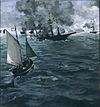
|
Naval battle between the Kearsarge and the Alabama (1864) |
134 cm × 127 cm oil on canvas |
1872 |
Museum of Art in Philadelphia |

|
Mocking Christ (1864-1865) |
190.8 cm × 148.3 cm oil on canvas |
1865 |
Art Institute in Chicago |

|
The tragic actor (1865) |
187.2 cm × 108.1 cm oil on canvas |
Rejected in 1866 |
National Gallery of Art in Washington, DC |

|
Piper (1866) |
161 cm × 97 cm oil on canvas |
Rejected in 1866 |
Musée d'Orsay in Paris |

|
Young lady with a parrot (1866) |
185.1 cm × 128.6 cm oil on canvas |
1868 |
Metropolitan Museum of Art in New York |
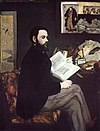
|
Portrait of Zola Musée d'Orsay, Paris (1867–1868) |
146 cm × 114 cm oil on canvas |
1868 |
Musée d'Orsay in Paris |

|
The balcony (1868) |
169 cm × 125 cm oil on canvas |
1869 |
Musée d'Orsay in Paris |

|
Breakfast in the studio (1868) |
118 cm × 153.9 cm oil on canvas |
1869 |
New Pinakothek in Munich |

|
The shooting of Emperor Maximilian of Mexico (1868–1869) |
252 cm × 305 cm oil on canvas |
Rejected in 1869 |
Kunsthalle in Mannheim |

|
The break (1869) |
148 cm × 113 cm oil on canvas |
1873 |
Rhode Island School of Design Museum in Providence |

|
Portrait of Eva Gonzalès (1869–1870) |
191 cm × 133 cm oil on canvas |
1870 |
National Gallery in London Dublin City Gallery The Hugh Lane in Dublin |

|
The Music Lesson (1870) |
141 cm × 173.1 cm oil on canvas |
1870 |
Museum of Fine Arts in Boston |
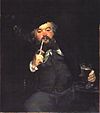
|
The good bock beer (1873) |
94.6 cm × 83 cm oil on canvas |
1873 |
Museum of Art in Philadelphia |

|
The Railroad (1873) |
93 cm × 114 cm oil on canvas |
1874 |
National Gallery of Art in Washington, DC |

|
The Swallows (1873) |
66 cm × 81 cm oil on canvas |
Rejected in 1874 |
EG Bührle Collection Foundation in Zurich |

|
Masked ball in the opera (1873) |
59 cm × 72.5 cm oil on canvas |
Rejected in 1874 |
National Gallery of Art in Washington, DC |

|
Argenteuil (1874) |
149 cm × 115 cm oil on canvas |
1875 |
Musée des Beaux-Arts in Tournai |

|
In the boat (1874) |
97.2 cm × 130.2 cm oil on canvas |
1879 |
Metropolitan Museum of Art in New York |

|
The Laundry (1875) |
145 × 115 cm oil on canvas |
1876 |
Barnes Foundation in Philadelphia |

|
The artist (1875) |
193 cm × 130 cm oil on canvas |
1876 |
Museu de Arte in São Paulo |

|
Faure in the role of Hamlet (1877) |
196 cm × 131 cm oil on canvas |
1877 |
Folkwang Museum in Essen |
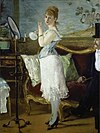
|
Nana (1877) |
154 cm × 115 cm oil on canvas |
Rejected in 1877 |
Art gallery in Hamburg |

|
In the winter garden (1879) |
115 cm × 150 cm oil on canvas |
1879 |
Old National Gallery in Berlin |

|
At Père Lathuille, outdoors (1879) |
92 cm × 112 cm oil on canvas |
1880 |
Musée des Beaux-Arts in Tournai |

|
Portrait of Antonin Proust (1880) |
129.9 cm × 95.9 cm oil on canvas |
1880 |
Museum of Art in Toledo, Ohio |

|
Pertuiset as a lion hunter (1880–1881) |
150 cm × 170 cm oil on canvas |
1881 |
Museu de Arte in São Paulo |

|
Portrait of Rochefort (1881) |
82 cm × 67 cm oil on canvas |
1881 |
Art gallery in Hamburg |

|
Spring (1881) |
73 cm × 51 cm oil on canvas |
1882 |
J. Paul Getty Museum in Los Angeles |

|
Bar in the Folies-Bergère (1881–1882) |
96 cm × 130 cm oil on canvas |
1882 |
Courtauld Institute of Art in London |
Manet on the art market
In 1989 Manet's painting “La Rue Mosnier aux drapeaux” (The Rue Mosnier with flags) was auctioned for the equivalent of 19.8 million euros. Other Manet paintings also fetched tens of millions. In 2010 one of his two self-portraits ( self-portrait with palette ) went up for auction at Sotheby’s London auction house and changed hands for £ 22.4 million. The J. Paul Getty Museum in Los Angeles acquired Christie’s Manet’s painting Spring for $ 65,125,000 in auction house Christie’s Manet’s New York branch on November 5, 2014 . It is the highest price ever paid for a Manet work at auction.
Honors
In France, several streets are named after Manet. There is a rue Édouard Manet in Paris , Asnières-sur-Seine , Créteil , Guilers , Hyères , Quincy-sous-Sénart and in Nouméa in the French overseas territory of New Caledonia . There is also a rue Manet in Le Blanc-Mesnil , Villepinte (Seine-Saint-Denis) , Croissy-sur-Seine and Chilly-Mazarin . There is also a street named after Édouard Manet in Limassol in Cyprus and in Kiryat Ata in Israel. In Germany there is an Edouard-Manet-Weg in Stuttgart and a Manetstraße in Leipzig and Berlin in the Hohenschönhausen district . In addition, schools were named after Manet. In France he was the namesake for the Collège Édouard Manet in Marseille and the Collège Édouard Manet in Villeneuve-la-Garenne . The Leipzig Anna Magdalena Bach School was called Edouard Manet School until 2014 . In 2009 the asteroid (11984) Manet was named after him.
Exhibitions
- In late 1910 and early 1911, the British painter and art critic Roger Fry organized the Manet and the Post-Impressionists exhibition at Grafton Galleries, London. The exhibition coined the term post-impressionism . Manet was represented with nine works, including Bar in the Folies Bergères (1881/1882).
- 1992: Edouard Manet, Moments in History. Städtische Kunsthalle Mannheim from October 18, 1992 to January 17, 1993.
- 2013: Manet. Ritorno a Venezia , Palazzo Ducale , Venice.
- 2016: Manet - See. The view of modernity. Kunsthalle Hamburg , Hamburg, from May 27 to September 4, 2016.
- 2017/2018: Edouard Manet . Von der Heydt-Museum , Wuppertal, from October 24, 2017 to February 25, 2018.
literature
- Edmond Bazire : Edouard Manet . Quantin, Paris 1884.
- Théodore Duret : Édouard Manet. His life and his art . Cassirer, Berlin 1910.
- Julius Meier-Graefe : Edouard Manet . Piper, Munich 1912.
- Antonin Proust : Édouard Manet, memories . Cassirer, Berlin 1917.
- Gotthard Jedlicka : Manet . Rentsch, Zurich 1941.
- Denis Rouart, Daniel Wildenstein: Edouard Manet: Catalog raisonné (2 vols.). Bibliothèque des Arts, Paris / Lausanne 1975.
- Réunion des Musées Nationaux Paris, Metropolitan Museum of Art New York (ed.): Manet 1832-1883 . (Catalog for the exhibition in the Galeries Nationales du Grand Palais , Paris, from April 22 to August 1, 1983 and in the Metropolitan Museum of Art , New York, from September 10 to November 27, 1983). Éditions de la Réunion des Musées Nationaux, Paris 1983, ISBN 2-7118-0230-2 . (German edition by Frölich and Kaufmann, Berlin 1984, ISBN 3-88725-092-3 )
- Pierre Schneider: Manet and his time . Time-Life-International, Amsterdam 1985, ISBN 90-6182-038-3 .
- Hajo Düchting : Manet, Parisian life . Prestel, Munich / New York 1985, ISBN 3-7913-1445-9 .
- TJ Clark : The Painting of Modern Life: Paris in the Art of Manet and His Followers. Thames & Hudson, London 1985, ISBN 0-500-23417-5 .
- Françoise Cachin : Manet . DuMont, Cologne 1991, ISBN 3-7701-2791-9 .
- Manfred Fath , Stefan Germer (ed.): Edouard Manet, Moments of History. Prestel, Munich 1992, ISBN 3-7913-1210-3 . (Catalog for the exhibition in the Städtische Kunsthalle Mannheim from October 18, 1992 to January 17, 1993)
- Michael Fried : Manet's Modernism: Or, the Face of Painting in the 1860s. University of Chicago Press, Chicago 1996, ISBN 0-226-26216-2 .
- Michel Foucault : The Painting of Manet. Merve Verlag, Berlin 1999, ISBN 3-88396-150-7 .
- Barbara Wittmann : Giving faces. Édouard Manet and the poetics of the portrait. Wilhelm Fink Verlag, Munich 2004, ISBN 3-7705-4005-0 .
- Joachim Kaak: Contemporary. On the painting by Édouard Manet. Sieveking Verlag, Munich 2014, ISBN 978-3-944874-04-3 .
- Oskar Bätschmann : Édouard Manet (Beck Knowledge). CH Beck, Munich 2015, ISBN 978-3-406-67712-0 .
- Pierre Bourdieu : Manet: A Symbolic Revolution. Suhrkamp, Berlin 2015, ISBN 978-3-518-58680-8 .
- Hubertus Gaßner , Viola Hildebrand-Schat (Ed.): Manet - Seeing: The view of modernity . Michael Imhof Verlag, Petersberg 2016, ISBN 978-3-7319-0325-3 . (Catalog for the exhibition in the Hamburger Kunsthalle, Hamburg, from May 26 to September 4, 2016)
- Gerhard Finckh (ed.): Edouard Manet. Von der Heydt-Museum, Wuppertal 2017, ISBN 978-3-89202-098-1 (catalog for the exhibition in the Von der Heydt-Museum, Wuppertal, from October 24, 2017 to February 25, 2018)
Movies
- Didier Baussy-Oulianoff: Edouard Manet (documentation, 55 min.). Arthaus Musik, Halle 2008, ISBN 978-3-939873-28-0 . (French orig. 1989)
- Waldemar Januzczak: Manet: The Man Who Invented Modern Art (documentary, 90 min.). UK 2009.
- Werner Raeune: Edouard Manet (documentation, 35 min.). Von der Heydt-Museum, Wuppertal 2017. (DVD)
Individual evidence
- ↑ Arlette Camion / Simona Hurst (eds.): Les lettres parisiennes du peintre Victor Müller , PU Paris-Sorbonne, Paris 2015, p. 25
- ^ Nitsche, Diana: Absinth - medical and cultural history of a pleasure drug , dissertation Institute History of Medicine, Ruprecht-Karls-Universität Heidelberg, supervisor Wolfgang U. Eckart , 2005, pp. 99 + 100.
- ↑ Kelly Crow: Self-Portrait Stars at Sotheby’s . The Wall Street Journal, June 23, 2010.
- ↑ Craig Nakano: Getty breaks record with $ 65.1-million purchase of Manet's' Spring , Los Angeles Times article, Nov. 5, 2014
- ↑ Information about the auction at www.christies.com
- ↑ Waldemar Januzczak: Manet: The Man Who Invented Modern Art. June 13, 2009, accessed on September 29, 2017 .
Web links
- Literature by and about Édouard Manet in the catalog of the German National Library
- Works by and about Édouard Manet in the German Digital Library
- Édouard Manet on kunstaspekte.de
- Works by Édouard Manet at Zeno.org .
- Video guide for “Bar in den Folies-Bergère” on the artinspector
- Manet on artcyclopedia.com (English)
- Edouard Manet - Breakfast in the Green Musée d'Orsay , Paris
- Édouard Manet in the Neue Pinakothek , Munich
- Édouard Manet, paintings, drawings, prints in the National Gallery of Art , Washington, DC
- Edouard Manet. Etchings. Exhibition at the Hamburger Kunsthalle from February 27 to August 2, 2009
| personal data | |
|---|---|
| SURNAME | Manet, Édouard |
| BRIEF DESCRIPTION | French impressionism painter |
| DATE OF BIRTH | January 23, 1832 |
| PLACE OF BIRTH | Paris |
| DATE OF DEATH | April 30, 1883 |
| Place of death | Paris |





